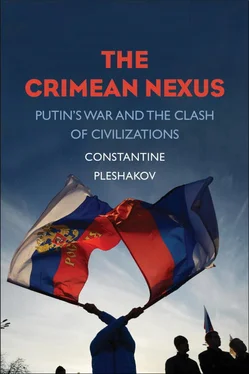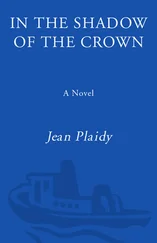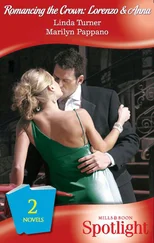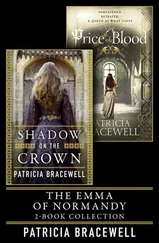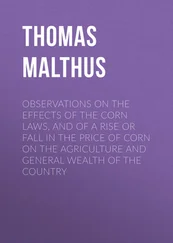Not undeservedly, Vladimir Putin took credit for the “reunification.” When he visited Sevastopol on May 9 (not coincidentally, V-Day in the Russian calendar) his theatrical entry into the bay onboard a warship was meant to look like the return of a king.
SEVEN
From Crimea to Donbass
Ninety-two United Nations member states refused to judge Russia’s actions in Crimea. The handful of countries that joined Russia in voting against the American-sponsored U.N. resolution to condemn the annexation were either perennially anti-American or eating from Moscow’s hand: Armenia, Belarus, Bolivia, Cuba, Nicaragua, North Korea, Sudan, Syria, Venezuela, and Zimbabwe. Their vote was to be expected. But among the countries that either abstained or did not vote were several third-world powerhouses and U.S. allies, including Afghanistan, Argentina, China, India, Iraq, Israel, and Pakistan. All were involved in territorial disputes with other countries; none wanted the West as an arbiter.
In Washington, support for Ukraine immediately became a bipartisan issue. On March 6, the House of Representatives approved $1 billion in financial aid to Kiev by a vote of 385 to 23. The White House introduced sanctions against Russia. Conservatives and liberals alike asked for an even stronger response. Senators John McCain, Lindsey Graham, and Robert Menendez demanded that Obama send weapons to Ukraine. Nicholas Kristof of the New York Times urged the president to act preemptively and start rescuing another post-Soviet nation potentially facing Russian intervention—Moldova. [1] Nicholas Kristof, “Moldova, the Next Ukraine,” New York Times , April 23, 2014.
Within weeks, the Moscow-supported “people’s republics” of Donetsk and Luhansk began battling Ukrainian forces. By March 2016, according to U.N. estimates, there were 9,160 deaths. [2] Nick Cumming-Bruce, “Death Toll in Ukraine Conflict Hits 9,160, U.N. Says,” New York Times , March 3, 2016.
In neither Ukraine nor Russia are Donetsk and Luhansk referred to as “eastern Ukraine,” a broad term that is applicable to several additional provinces. The region is called Donbass.
Donbass stands for “Donetz Coal Basin”—the Donetz a river, and coal the essence of the local economy. Donbass is part of the steppes. It supported no urban centers before the Russian Empire secured it, and no significant towns until coal became an indispensable commodity in the second half of the nineteenth century. Almost every settlement was born as a mining town, and most remain mining towns today. The peak of development happened in the 1920s and 1930s. As a result, the foundations of Donbass social norms and human geography are neither Ukrainian nor Russian, but Soviet, formed by central planning serving the needs of industrialization. Migration of a skilled workforce, establishment of vocational and technical education, city planning—nothing was spontaneous. Donbass is a product of social engineering. Nowadays, its coal deposits depleted and heavy industry outdated, many towns of Donbass resemble former mill towns in the American Northeast: places where economic depression manifests itself in decay, unemployment, poverty, and anger.
The exact mechanism of the separatist insurgency in Donbass is still not known, but it was neither a grassroots revolution, as Moscow claims, nor a conspiracy cooked up in the Kremlin, as Kiev insists. The overthrown president of Ukraine, Viktor Yanukovych, was from Donbass, and his ouster was a victory of Donbass’s nemesis—nationalist Galicia.
The whole of Ukraine was in turmoil between February and April of 2014, and at first, the rallies in Donbass did not look so different from those roaring in Lviv or Odessa. When pro-Russian activists in Donetsk and Luhansk proclaimed “people’s republics,” it sounded almost like comic relief. It took the Kremlin to turn a soap opera into a war.
It does not look as if Moscow planned the infiltration of eastern Ukraine as a smooth continuation of the expansion begun in Crimea. Nor was it attempting, as it is often argued, to create a land corridor to Crimea along the coast of the Sea of Azov. No Russian traffic there would ever be safe from Ukrainian paramilitary attacks. Most likely, Putin opted for the escalation because he was angered by the U.S. reaction to the “ascension” of Crimea into Russia, yet scornful of the first round of sanctions. Indeed, in the spring of 2014, they did not bite. Like a willful cat testing the limits of what he can get away with, the Russian leader supported the separatist insurgency with no endgame in mind except to further destabilize Ukraine. As Andrew S. Weiss put it, “Mr. Putin’s efforts look more like a short-term tactical play than a carefully considered embrace of an ethnocentric approach to defending Russia’s declared interests in the neighborhood”—and that was precisely what made the Ukraine showdown “even scarier and more dangerous.” [3] Andrew S. Weiss, “Putin the Improviser,” Wall Street Journal , February 20, 2015.
It is not impossible that Putin also saw the stealth invasion as an opportunity to perfect the hybrid warfare first applied in Crimea, a novel stratagem blurring the lines between soft and hard power, already praised by Western military professionals. A former NATO commander, Admiral James G. Stavridis, said he admired the “finesse” of the campaign in Crimea and that the strategy was applicable “no matter where you are operating in the world.” [4] Michael R. Gordon, “Russia Displays a New Military Prowess in Ukraine’s East,” New York Times , April 21, 2014.
The first important step was the decision to prompt Russian volunteers to organize through the Internet, set up recruiting sites and physical training camps and, last but not least, let them cross the Russo-Ukrainian border with weapons. Some of the most notorious volunteer commanders later claimed full responsibility for what happened next. “If my group had not crossed the border,” one of them boasted, there would have been no real fighting: “Just a few dozen killed, burned, arrested. That would have been all.” [5] “Strelkov priznal otvetstvennost’ za voyennye deistviya na Ukraine,” Lenta.ru, November 20, 2014, http://lenta.ru/news/2014/11/20/strelkov (retrieved November 20, 2014).
From the Ukrainian side, the “pro-government” forces also consisted largely of volunteers. The so-called volunteer battalions belonged to far-right groups and egomaniac millionaires. Azov Battalion, originating in the neo-Nazi movement, wore Waffen-SS symbols on its insignia. The billionaire Ihor Kolomoyski equipped the Dnipro Battalion. [6] David Stern, “Ukraine Underplays Role of Far Right in Conflict,” BBC, December 13, 2014, www.bbc.com/news/world-europe-30414955 (retrieved December 13, 2014).
And so on.
Radicals from Russia crossed into Donbass with ease. So did soldiers of fortune and sociopaths. Tim Whewell of the BBC described a grotesque mix of monarchists, secular nationalists, Orthodox mystics, and people who had signed up to “save the Russian state” from Western aggression. Aptly, Whewell reminded readers about the Russian tradition of volunteering abroad to protect Slavic “brethren”: in Tolstoy’s Anna Karenina , after the heroine dies, her lover Vronsky signs up to fight against the Turks in Serbia. In the 1990s, Russians fought alongside Serbs in the Yugoslav wars.
Other fighters were “clearly driven partly by an existentialist quest to give meaning to their lives,” reading Albert Camus and Jean-Paul Sartre between battles. Because they all kept their mouths shut, it was impossible to tell whether a young man had joined the separatists “in search of money or adventure” or had been “ordered to Ukraine as part of an unofficial mission that will never be acknowledged,” an article in the New York Times Magazine reported. [7] Tim Whewell, “The Russians Fighting a ‘Holy War’ in Ukraine,” BBC, December 17, 2014, www.bbc.com/news/magazine-30518054 (retrieved December 18, 2014); Joshua Yaffa, “The Inconvenient Soldier,” New York Times Magazine , January 11, 2015, p. 49.
Читать дальше
